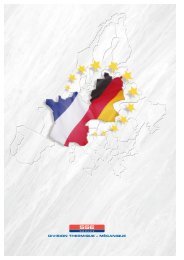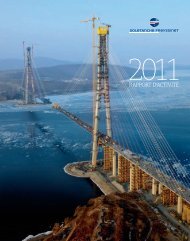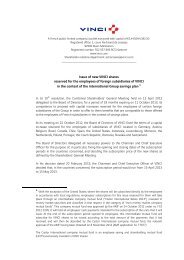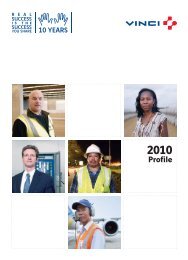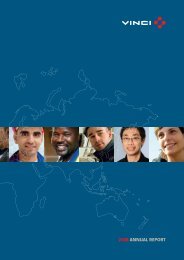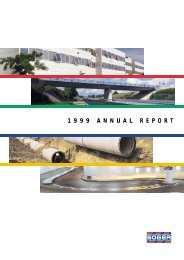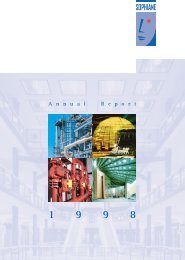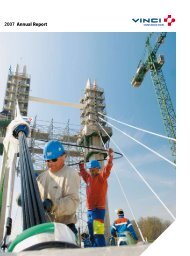VINCI - 2005 annual report
VINCI - 2005 annual report
VINCI - 2005 annual report
Create successful ePaper yourself
Turn your PDF publications into a flip-book with our unique Google optimized e-Paper software.
A RESPONSIBLE GROUP / ENVIRONMENTAL RESPONSIBILITY<br />
On 70% of Sogea<br />
Construction<br />
worksites, mineral<br />
oils are used<br />
instead of<br />
vegetable oils for<br />
stripping formwork.<br />
136<br />
<strong>VINCI</strong> <strong>2005</strong> ANNUAL REPORT<br />
the sustainable development competition<br />
organised by UNPG, the French national<br />
union of aggregate producers, for their use<br />
of household waste incineration bottom ash<br />
in the construction of an interchange on the<br />
A15 motorway in the Val d’Oise region (see<br />
p. 134).<br />
ALTERNATIVE<br />
PROCESSES<br />
Eurovia has continued to develop processes<br />
that reduce the consumption of materials in<br />
road building. Recyclovia ® , for instance, is<br />
a cold in situ recycling process launched in<br />
<strong>2005</strong> for repairing the road surface. Another<br />
new process, Polybitume C, optimises the<br />
recycling of used tyres and improves the<br />
properties of asphalt containing this material,<br />
which can be laid at the same temperature<br />
as pure asphalt. Developed by Eurovia’s<br />
Spanish subsidiary, Probisa, this process<br />
won a special sustainable development<br />
award in the <strong>VINCI</strong> <strong>2005</strong> Innovation Awards<br />
Competition.<br />
Eurovia and <strong>VINCI</strong> Construction subsidiaries<br />
specialising in demolition and deconstruction<br />
continue to develop solutions that optimise<br />
the rate of materials reuse.<br />
Reducing energy<br />
consumption<br />
In <strong>2005</strong>, <strong>VINCI</strong> companies continued their<br />
efforts to reduce energy consumption. This<br />
priority area for improvement, common<br />
to all of them, is implemented through a<br />
number of different programmes.<br />
ELECTRICITY<br />
CONSUMPTION<br />
Initiatives designed to limit energy consumption<br />
on worksites included “Home<br />
vert”, a new type of site hut developed and<br />
tested in <strong>2005</strong> by GTM Construction in<br />
partnership with ADEME, France’s environment<br />
and energy management agency. The<br />
stakes are high: heating and air-conditioning<br />
the company’s 3,000 huts accounts for 60%<br />
of electricity consumption on its sites, i.e.<br />
estimated <strong>annual</strong> production of 5,300 tonnes<br />
of greenhouse gases. The installation of a<br />
building automation system, together with<br />
better heat insulation to reduce the number<br />
of thermal bridges, saves 3,000 kWh a year<br />
per site accommodation complex.<br />
WARM MIX ASPHALTS<br />
TO SAVE ENERGY<br />
One of the main areas of Eurovia’s research<br />
and development programme is reducing<br />
the temperature to which aggregates have to<br />
be heated for road surfacing. The company’s<br />
Aspha-Min ® process brings the asphalt<br />
mix production temperature down 30°C<br />
and reduces energy consumption by 20%.<br />
It won the FNTP (French public works<br />
federation) innovation award in May <strong>2005</strong>,<br />
and the grand prize for innovation at the<br />
trade fair for French mayors and municipalities<br />
in November.<br />
FUEL CONSUMPTION<br />
Greenhouse gas emissions associated with<br />
<strong>VINCI</strong>’s business activities are attributable<br />
mainly to its fl eet of 30,000 service vehicles<br />
and 5,000 site vehicles. As part of the<br />
Group’s purchasing policy, buyer training<br />
and awareness raising initiatives, combined<br />
with the programme to reduce the risk of<br />
road accidents, have led to action being<br />
taken on a number of fronts. These include<br />
controlling fuel consumption, detecting<br />
potential malfunctions in engines, preventing<br />
dangerous driving habits, and the achievement<br />
of considerable savings. In <strong>2005</strong>, <strong>VINCI</strong><br />
set 2.5% as the target for reducing vehiclerelated<br />
greenhouse gas emissions. Numerous<br />
initiatives have been taken at business unit<br />
level.<br />
At Roissy-Charles de Gaulle, half of the<br />
vehicles operated by EFS-WFS, the <strong>VINCI</strong><br />
Concessions airport services subsidiary, run<br />
on electricity. The company has also launched<br />
a carbon assessment scheme with Aéroports<br />
de Paris and ADEME (France’s environment<br />
and energy management agency). At<br />
<strong>VINCI</strong> Energies, several business units have<br />
acquired dual energy (internal combustion<br />
and electricity) mobile inspection platforms,<br />
and German business units decided to buy<br />
service vehicles fi tted with particulate fi lters.<br />
In Africa, Sogea-Satom continued its vehicle<br />
replacement programme and reached its<br />
intermediate target: 45% of all vehicles are<br />
now compliant with European fuel consumption<br />
standards.




